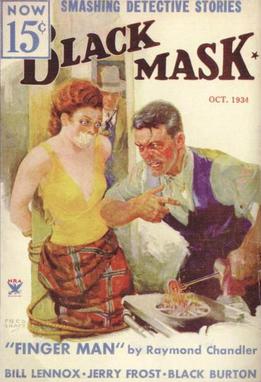Film noir
File:The Stranger (1946) by Orson Welles.webm
Cinematic term used primarily to describe stylish Hollywood crime dramas
Film noir is a cinematic term used primarily to describe stylish Hollywood crime dramas, particularly those that emphasize cynical attitudes and sexual motivations. The term film noir, French for "black film" or "dark film," was first applied to Hollywood films by French critic Nino Frank in 1946, but was unrecognized by most American film industry professionals of that era.
Characteristics[edit | edit source]
Film noir encompasses a range of plots, but the central theme often revolves around crime, moral ambiguity, and complex characters. The visual style of film noir is heavily influenced by German Expressionism, featuring stark lighting contrasts, deep shadows, and unusual camera angles. The narrative style often includes flashbacks, voice-over narration, and intricate plots.
Historical Context[edit | edit source]
Film noir emerged in the early 1940s and continued into the late 1950s. The genre was influenced by the disillusionment following World War II and the influx of European filmmakers to Hollywood. Classic film noir is often associated with the Great Depression and the Cold War era, reflecting the societal anxieties of those times.
Notable Films[edit | edit source]
Some of the most iconic films in the film noir genre include:
- The Maltese Falcon (1941)
- Double Indemnity (1944)
- Sunset Boulevard (1950)
- The Big Sleep (1946)
- Touch of Evil (1958)
Subgenres and Influence[edit | edit source]
Film noir has given rise to several subgenres, including neo-noir and tech-noir. Neo-noir films, such as Chinatown (1974) and Blade Runner (1982), update the themes and visual style of classic film noir for contemporary audiences. Tech-noir combines elements of film noir with science fiction, as seen in films like The Terminator (1984).
Legacy[edit | edit source]
The influence of film noir extends beyond cinema to literature, television, and other forms of media. The genre has inspired numerous television series, graphic novels, and video games. Its themes of moral ambiguity and complex characters continue to resonate with audiences today.
See also[edit | edit source]
References[edit | edit source]
External links[edit | edit source]
Search WikiMD
Ad.Tired of being Overweight? Try W8MD's NYC physician weight loss.
Semaglutide (Ozempic / Wegovy and Tirzepatide (Mounjaro / Zepbound) available. Call 718 946 5500.
Advertise on WikiMD
|
WikiMD's Wellness Encyclopedia |
| Let Food Be Thy Medicine Medicine Thy Food - Hippocrates |
Translate this page: - East Asian
中文,
日本,
한국어,
South Asian
हिन्दी,
தமிழ்,
తెలుగు,
Urdu,
ಕನ್ನಡ,
Southeast Asian
Indonesian,
Vietnamese,
Thai,
မြန်မာဘာသာ,
বাংলা
European
español,
Deutsch,
français,
Greek,
português do Brasil,
polski,
română,
русский,
Nederlands,
norsk,
svenska,
suomi,
Italian
Middle Eastern & African
عربى,
Turkish,
Persian,
Hebrew,
Afrikaans,
isiZulu,
Kiswahili,
Other
Bulgarian,
Hungarian,
Czech,
Swedish,
മലയാളം,
मराठी,
ਪੰਜਾਬੀ,
ગુજરાતી,
Portuguese,
Ukrainian
Medical Disclaimer: WikiMD is not a substitute for professional medical advice. The information on WikiMD is provided as an information resource only, may be incorrect, outdated or misleading, and is not to be used or relied on for any diagnostic or treatment purposes. Please consult your health care provider before making any healthcare decisions or for guidance about a specific medical condition. WikiMD expressly disclaims responsibility, and shall have no liability, for any damages, loss, injury, or liability whatsoever suffered as a result of your reliance on the information contained in this site. By visiting this site you agree to the foregoing terms and conditions, which may from time to time be changed or supplemented by WikiMD. If you do not agree to the foregoing terms and conditions, you should not enter or use this site. See full disclaimer.
Credits:Most images are courtesy of Wikimedia commons, and templates, categories Wikipedia, licensed under CC BY SA or similar.
Contributors: Prab R. Tumpati, MD




